Gigabyte Z77-HD4 Review
by Ian Cutress on May 19, 2013 10:00 AM EST- Posted in
- Motherboards
- Gigabyte
- Z77
Rightmark Audio Analyzer 6.2.5
In part due to reader requests, we are pleased to include Rightmark Audio Analyzer results in our benchmark suite. The premise behind Rightmark:AA is to test the input and output of the audio system to determine noise levels, range, harmonic distortion, stereo crosstalk and so forth. Rightmark:AA should indicate how well the sound system is built and isolated from electrical interference (either internally or externally). For this test we connect the Line Out to the Line In using a short six inch 3.5mm to 3.5mm high-quality jack, turn the OS volume to 100%, and run the Rightmark default test suite at 48 kHz, 96 kHz and 192 kHz. We look specifically at the Dynamic Range of the audio codec used on board, as well as the Total Harmonic Distortion + Noise.
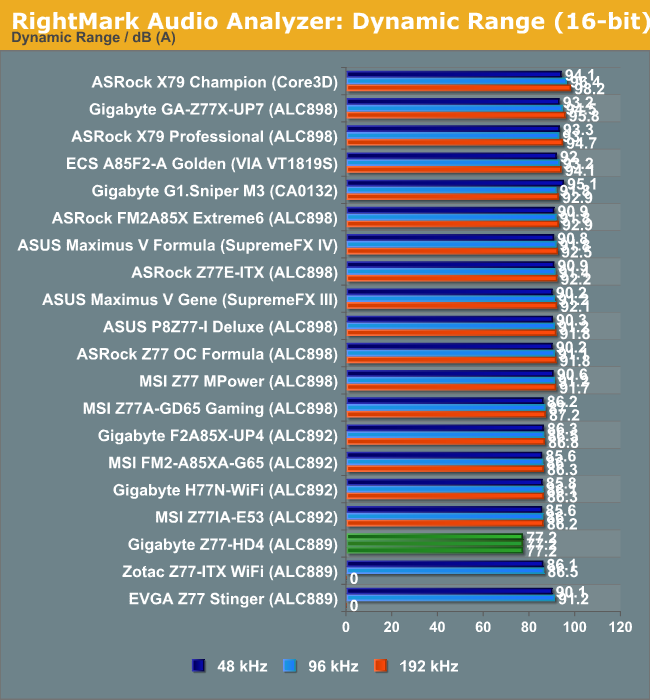
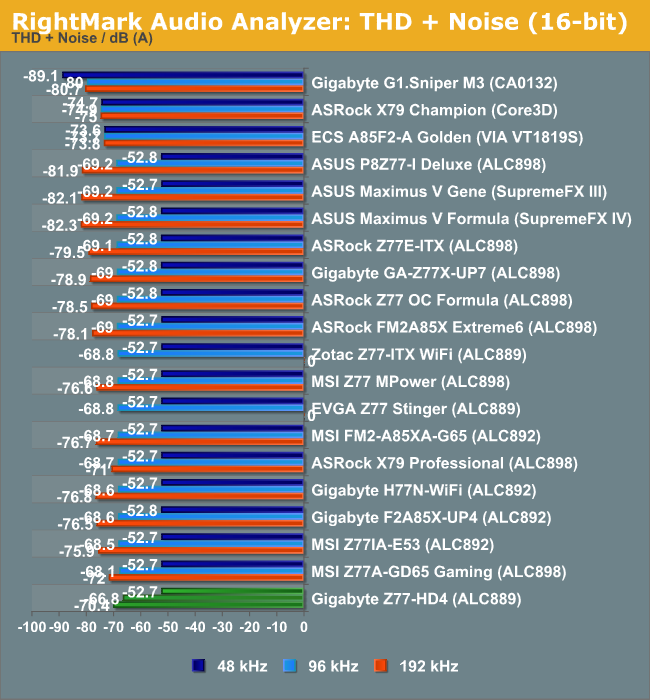
With the price of the board, we get one of the cheaper Realtek audio options. It performs worse in our testing than the ALC89x and above, but is able to pass our 192 kHz test unlike the ALC889 mITX versions.
USB 3.0 Backup
For this benchmark, we run CrystalDiskMark to determine the ideal sequential read and write speeds for the USB port using our 240 GB OCZ Vertex3 SSD with a SATA 6 Gbps to USB 3.0 converter. Then we transfer a set size of files from the SSD to the USB drive using DiskBench, which monitors the time taken to transfer. The files transferred are a 1.52 GB set of 2867 files across 320 folders – 95% of these files are small typical website files, and the rest (90% of the size) are the videos used in the WinRAR test.
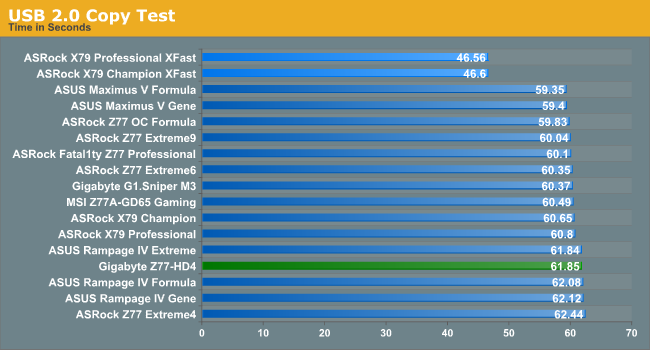
USB 2.0 performance is middling, on the wrong side of 61 seconds but only a fraction worse than the top non-XFast score.
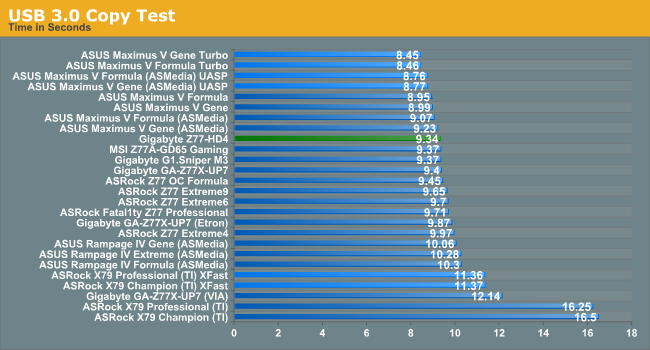
By contrast, the USB 3.0 performance is nearer the sharp end, despite sequential write speeds not being the best.
DPC Latency
Deferred Procedure Call latency is a way in which Windows handles interrupt servicing. In order to wait for a processor to acknowledge the request, the system will queue all interrupt requests by priority. Critical interrupts will be handled as soon as possible, whereas lesser priority requests, such as audio, will be further down the line. So if the audio device requires data, it will have to wait until the request is processed before the buffer is filled. If the device drivers of higher priority components in a system are poorly implemented, this can cause delays in request scheduling and process time, resulting in an empty audio buffer – this leads to characteristic audible pauses, pops and clicks. Having a bigger buffer and correctly implemented system drivers obviously helps in this regard. The DPC latency checker measures how much time is processing DPCs from driver invocation – the lower the value will result in better audio transfer at smaller buffer sizes. Results are measured in microseconds and taken as the peak latency while cycling through a series of short HD videos - under 500 microseconds usually gets the green light, but the lower the better.
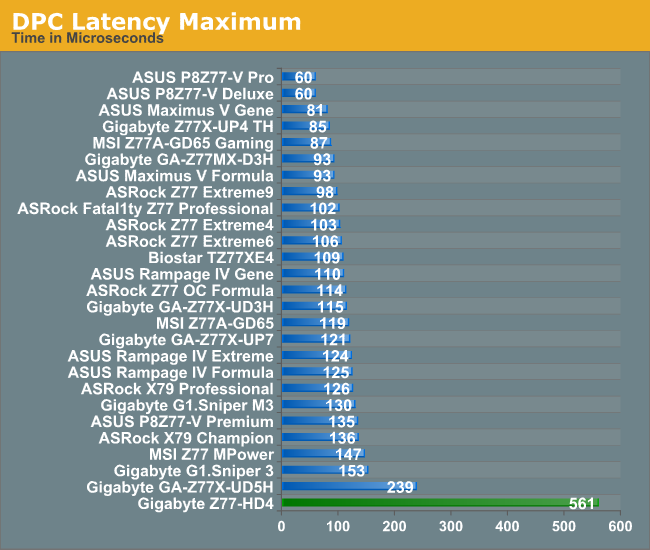
A major realisation of having that un-optimised BIOS is perhaps shown best in the DPC. To start, with the default install, the monitoring features of ET6 causes the DPC to peak at over 800 microseconds. Disabling this software causes a maximum of around 114 microseconds, although every so often we encountered a peak of around 300-500 microseconds, and 561 was recorded as the highest peak.










63 Comments
View All Comments
kasakka - Monday, May 20, 2013 - link
WTF, does this actually have a manual VCore setting when the similarly priced DS3H didn't? Damn Gigabyte and their gazillion different models.kmmatney - Monday, May 20, 2013 - link
Yeah - that's a bit frusterating. I bought the DS3H knowing it didn't have Vcore setting, as my plan was to overclock as high as I could at stock voltage. However, while I was hoping to get to 4.5 Ghz (as a few other were able to do), mine crapped out at 4.3 Ghz, and I run it at 4.2 to be safe. More than enough performance really, and not a bad overclock from 3.4 Ghz, but I'm curious to see what it could do a VCore adjustment.kasakka - Tuesday, May 21, 2013 - link
I did the same and also ran into similar problems, though mine would boot at 4.5 but crash on benchmarks. I exchanged the board for a UD3H and now running 4.5 stable at lower voltage than what the DS3H would set, the CPU boots at 4.7 but didn't bother working to make it stable at that speed.What annoys me is that Gigabyte doesn't disclose the lack of VCore adjustment anywhere and there are other strange things like how the DS3H uses all-Intel USB ports whereas the UD3H is a combination of VIA and Intel controllers (with the VIA not working unless a driver is installed). I really sometimes wonder what is going thru mobo developers' heads.
Flunk - Monday, May 20, 2013 - link
It's nice that you're reviewing more commodity hardware, but this board is already being liquidated by the computer shops in my area. Intel has a new line of chips just around the corner. This review would have been a lot more helpful this time last year.lever_age - Monday, May 20, 2013 - link
Hopefully it's just an indication of more things to come. But yeah, coverage of the AsRock Pro3/Pro4, MSI G4x, Asus LX/LK, Gigabyte HD/D(S)3, etc. of the world would be nice. And the stuff under that as well. You know, the stuff you put in or recommend to friends, family, etc.Though to nitpick, this /particular/ board wasn't available until relatively late in Z77's reign.
rangerdavid - Monday, May 20, 2013 - link
Yeah, $5,600 / year is just about right for someone if they "sit at home, music playing while they 'work' in front of my iMac."Alan G - Monday, May 20, 2013 - link
I'm probably one of the older folks who reads these reviews. I haven't played a computer game (not counting Free Cell) since the Tex Murphy series ended way back when. Clearly one can spend a lot or a little on a build. I just finished a new build for photography and found reviews on this site particularly valuable (I ended up getting a Fractal Designs Arc Midi case in part because of the good overview). I needed a build that would run quiet (computer sits about 18 inches away from me) and would perform. Interestingly, my main software Adobe Lightroom really doesn't require a GPU and would run satisfactorily just using the Ivy Bridge on board graphics; Photoshop is a different matter and some operations do take advantage of a good GPU. Many reviewers of GPUs may not be aware of this and tend to focus only on the gaming community.Motherboards such as this one do have a place in builds for specialty purposes when price might be a key point. I can build a killer photo editing PC for under $700 and not sacrifice any performance. Adding some bells and whistles is nice but not necessary.
jabber - Tuesday, May 21, 2013 - link
Indeed, I have a lot of customers that really don't care about day glow slots and surround sound but they want a serious spec machine for heavy tasks.nathanddrews - Tuesday, May 21, 2013 - link
http://www.youtube.com/watch?v=9gSQg1i_q2gcrashtech - Tuesday, May 21, 2013 - link
The internet cafe comment seems out of place in an article with global readership.